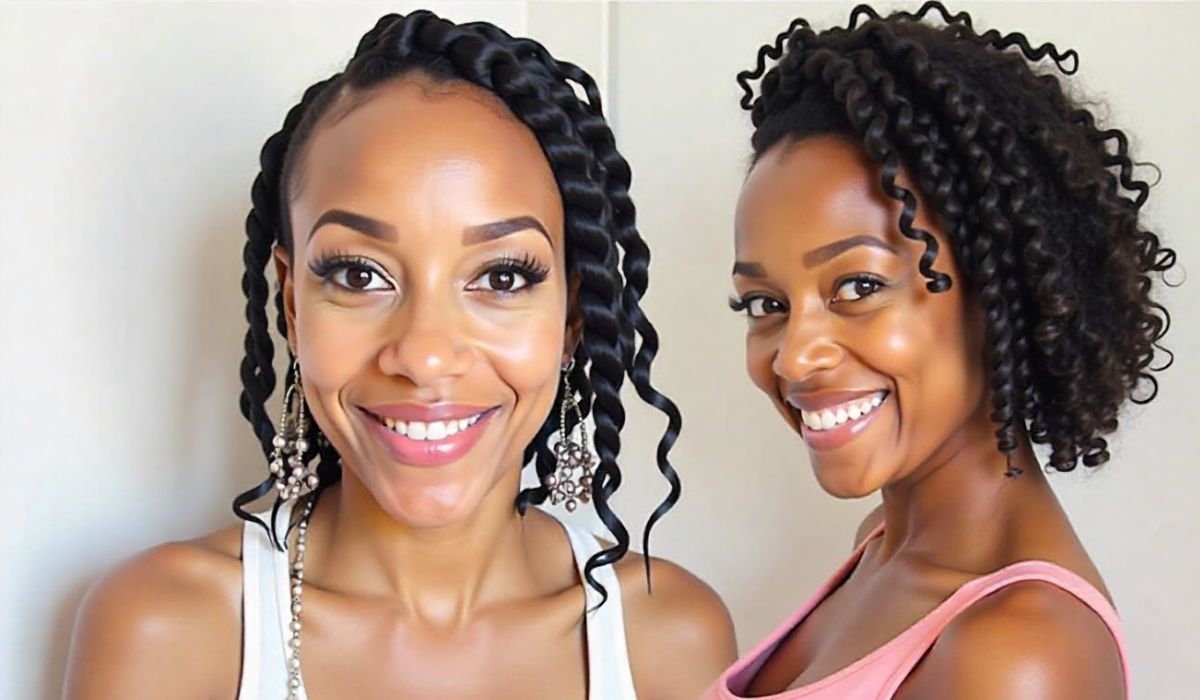Ever wondered how some people achieve that perfect blend of effortless cool and head-turning style? It often comes down to the details, and one of the most iconic details in hair fashion is the Cuban twist. More than just a hairstyle, it’s a statement of texture, culture, and versatility that has dominated trends for decades. Whether you’ve seen them on your favorite celebrity or admired them from afar, you’re probably curious about what they are, how they’re done, and if they’re right for you. Let’s unravel everything you need to know about this timeless look.
Let’s start with the basics. Imagine a hairstyle that combines the protective nature of braids with the unique, rope-like texture of twists. That’s the essence of Cuban twist braids. They are a type of protective style created by twisting two strands of hair—either your own or added extensions—around each other to form a dense, springy, and defined coil.
People often confuse them with other braided styles, so here’s a quick breakdown to clear things up:
- Cuban Twists vs. Senegalese Twists: Senegalese twists are typically flatter and smoother, created with a different twisting technique that results in a more uniform, less “bumpy” appearance. Cuban twists, on the other hand, are known for their pronounced, textured, almost bumpy look that gives them more volume and a distinct silhouette.
- Cuban Twists vs. Marley Twists: This one is about the hair material. Marley twists use a specific type of kinky, coily synthetic hair that mimics natural Afro-textured hair. Cuban twists can be made with various hair types, but often use a shinier, synthetic hair that contributes to their classic look.
The beauty of this style lies in its duality. It’s a fantastic protective style that allows your natural hair to rest from daily manipulation and environmental damage, all while giving you a fierce, fashion-forward look that can last for weeks.
So, what’s all the hype about? Why do people keep coming back to this particular style? The benefits are genuinely impressive.
- Ultimate Protection: Think of your hair getting a long, well-deserved vacation. Tucked away within the twists, your natural strands are shielded from breakage, humidity, and the stress of heat styling.
- Low-Maintenance Lifestyle: Once installed, your morning routine becomes incredibly simple. A quick moisturizing spritz, a little scalp oil, and you’re pretty much good to go. This is a game-changer for busy schedules.
- Style Versatility for Days: Don’t let anyone tell you braids are limiting. With Cuban twists, you can wear them down in a stunning cascade, pile them up into a chic high bun, style a half-up, half-down look, or even experiment with ponytails and space buns. The options are endless.
- A Confidence Boost: There’s something incredibly empowering about a hairstyle that has such a strong cultural presence and undeniable aesthetic appeal. It’s a look that commands attention and makes you feel put-together effortlessly.
Ready to take the plunge? Whether you’re heading to a salon like a Ulta Beauty or Sally Beauty stylist who specializes in braids, or you’re a DIY warrior, knowing the process is key.
Consultation is Key: First, have a chat with your stylist (or yourself!) about the desired outcome. How long do you want them? How thick? What color? Bringing inspiration photos is always a great idea.
The Installation Process:
- Preparation: Your natural hair will be washed, deep-conditioned, and thoroughly detangled. This ensures a clean, healthy foundation for the weeks ahead.
- Sectioning: The hair is meticulously parted into small, neat squares. The size of these sections determines the thickness of your final twists.
- Braid-In or Twist-Down: The stylist will often start with a small braid or flat twist at the root. This “anchor” is crucial for securing the added hair and ensuring the style doesn’t slip or put too much tension on your scalp.
- The Twisting: This is where the magic happens. The stylist takes a piece of the extension hair, folds it over your natural hair at the root, and begins twisting the two sections together in a consistent, downward motion. The goal is a uniform, tight twist from root to tip.
Read also: Your Guide to Stunning Human Hair Blonde Wigs Under $70
Table: At-Home vs. Professional Installation
| Feature | Doing It Yourself | Going to a Salon |
| Cost | Lower (cost of hair products) | Higher (labor-intensive service) |
| Time Commitment | Can take 6-12 hours, often split over days | Typically 4-8 hours in one sitting |
| Skill Level Required | Requires practice and patience | Expert hands ensure a flawless finish |
| Control & Customization | Complete control over every detail | Relies on clear communication with the stylist |
| Scalp Health & Tension | Risk of installing twists too tightly | A pro knows how to avoid excess tension |
Your work isn’t over once the twists are in. Proper aftercare is what separates a good style from a great one that lasts.
- Moisture is Non-Negotiable: Your scalp and hair still need hydration. Use a lightweight leave-in conditioner spray or a mix of water and aloe vera juice in a spray bottle every few days. Follow up with a sealing oil like Jamaican Black Castor Oil or argan oil on your scalp and the length of the twists.
- Nighttime Protection: Don’t just sleep on cotton pillows! The friction will cause frizz and tangling. Always wrap your hair in a satin or silk bonnet or use a satin pillowcase. It’s like putting your twists in a smooth, frictionless cocoon for the night.
- Cleaning Without the Mess: Yes, you can and should wash your hair! Mix a diluted shampoo with water in an applicator bottle and gently apply it to your scalp, massaging with your fingertips. Rinse thoroughly. Focusing the water on your scalp and letting it run down the twists avoids excessive frizz.
- Frizz Control: A little frizz is natural and adds character, but to tame flyaways, you can use a small amount of edge control or a light gel on a toothbrush to smooth down the baby hairs and roots.
Boredom is not an option. Here are some fresh ways to wear your twists:
- The Classic Shoulder-Length Bob: A timeless, chic look that frames the face beautifully. It’s professional yet stylish.
- High Bun with Statement Earrings: Pull your twists up into a voluminous bun on the crown of your head. This is the perfect way to show off a pair of dramatic earrings.
- Half-Up, Half-Down Crown: Take the front section of your twists and tie them back into a small bun or ponytail at the back of your head, creating a regal crown effect.
- Side-Swept Curtain: Part your twists deeply to one side and let them cascade over your shoulder. It’s an effortlessly glamorous look.
- Colorful Accents: Don’t be afraid of color! Add a few strands of burgundy, blue, or blonde twists throughout for a pop of personality.
The Cuban twist is more than a fleeting trend; it’s a versatile, protective, and powerful hairstyle that can simplify your life and elevate your style. Remember to prioritize a healthy installation, commit to a simple maintenance routine, and have fun experimenting with different looks. Your hair is your canvas, and Cuban twists offer a beautiful way to express yourself.
What’s your favorite way to style your twists? Share your looks and tips with us in the comments below!
1. How long do Cuban twists typically last?
With proper care, Cuban twists can last anywhere from 4 to 8 weeks. It’s important not to keep them in longer than that to prevent matting and potential damage to your natural hair.
2. What type of hair is best for Cuban twists?
Kanekalon braiding hair is the most popular and recommended choice. It’s synthetic, heat-friendly, and has a texture that blends seamlessly to create authentic-looking twists.
3. Do Cuban twists damage your hair?
When installed correctly without excessive tension and maintained properly, they are a protective style that should not cause damage. However, if they are put in too tightly, left in for too long, or not cared for, they can lead to breakage or traction alopecia.
4. Can I get Cuban twists with short hair?
Absolutely! The braiding technique used at the root allows stylists to attach extensions to even relatively short hair. The length will come entirely from the added hair.
5. How much do Cuban twists usually cost?
The cost varies widely based on your location, the salon’s reputation, and the length and thickness of the twists. You can expect to pay anywhere from $150 to $400 or more.
6. How do I take down Cuban twists without breaking my hair?
Be patient! Use a pair of sharp, pointy scissors to carefully snip the tip of each twist. Unravel the twist slowly from the bottom up. Follow up with a gentle, clarifying wash and a deep conditioning treatment.
7. Are Cuban twists heavy?
They can be, depending on the length and thickness. If you have a sensitive scalp or are getting very long twists, be prepared for some initial weight. A professional stylist can advise on a comfortable size for you.
You may also like: Cheap Wigs That Look Real: Our Top Tips & Tricks

